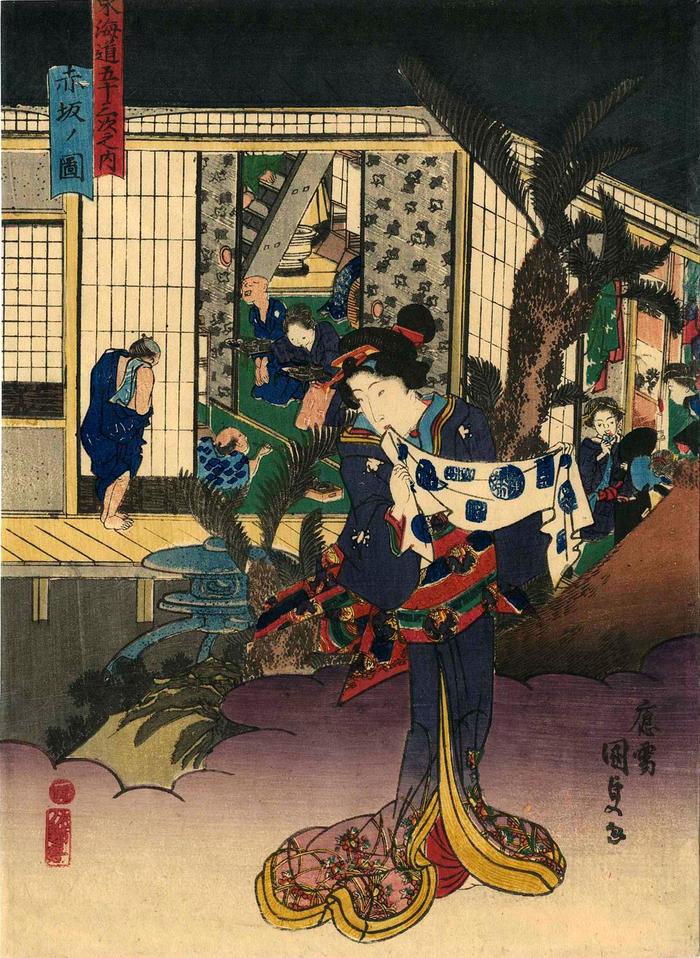Utagawa Kunisada (歌川国貞) / Toyokuni III (三代豊国) (artist 1786 – 01/12/1865)
View of Akasaka (Akasaka no zu: 赤坂ノ図) from the series Fifty-three Stations of the Tōkaidō Road (Tōkaidō gojūsan tsugi no uchi: 東海道五十三次之内)
ca 1838
Signed: ōju Kunisada ga (応需国貞画)
Publisher: Sanoy Kihei
Censor's seal: kiwame
Museum of Fine Arts, Boston
Library of Congress
Achenbach Foundation
Museum für angewandte Kunst, Vienna
Honolulu Museum of Art
Musuem of Fine Arts, Boston - Hiroshige's source print
National Diet Library
Spencer Museum of Art
Royal Museums of Art and History, Belgium (via Cultural Japan)
Virginia Museum of Fine Art - in black and white - misidentified as being Kameyama
Ishikawa Prefectural Museum of Art - they date their copy to 1836
Bryn Mawr
Honolulu Museum of Art
Fujisawa Ukiyo-e Museum
Victoria and Albert Museum
Nelson-Atkins Museum of Art In each of the prints by Kunisada a beautiful woman is placed in the foreground, removed from the Hiroshige inspired background. The bijin appears on a cloud motif which isolates her and helps to separate her from the original Hiroshige image. This is as much an excuse to feature beautiful woman as it is to link to and honor the Hiroshige set.
It should also be noted that the use of a cloud motif is not unique to Kunisada. Many artists before him used this template. However, the Japanese are not alone in this effort to present two different stories or concepts in a single piece. During the Renaissance in Europe similar constructs were used to present religious figures marked off from secular viewers. The principle is the same, but the application is different. The two cultures are not related in this way, but each came independently to the same conclusion of how to portray two variant concepts in one picture.
This is number 37 in the series, based on the earlier print design by Hiroshige. This, in fact, is the only one in the Hiroshige series that shows no landscape, but rather focuses on the interior of an inn. The teahouse women of Goyu and Asakasa were particularly popular. In Hiroshige's version you can see women applying makeup in the lower right in preparation for new visitors. In the courtyard is a squat palm tree with its easily recognizable fronds.
A close examination of the differences between the individual prints in the Kunisada series and their corresponding Hiroshige inspirations are striking and worth exploring.
Hiroshige at Philadelphia Museum of Art
One of the immediate indicators that this is from a later edition can be found in the printing of the white tenugui or hand-towel decorated with deep blue seals. In earlier editions these seals a printed much more precisely - almost to the point of being readable - but in later editions they are blurred and smudged much as they appear here.
****
Gian Carlo Calza in his description in Hiroshige: The Master of Nature of the original Hiroshige print re-imagined in this scene said: "Dominated by a large cycad and blue stone lantern in the garden, the scene takes place in a rest house offering a broad variety of services, as was common practice at most of the post stations. A customer just back from his bath stands outside his room on the engawa, the walkway that runs around the house and connects the different wings. Inside the room, his travelling companion is lying on the floor smoking a pipe while a maidservant brings two trays with dinner and a blind masseur to her right describes his services. Further back, another guest is coming down the stairs from the upper floor. In the room to the right, three girls are getting ready to entertain their guests... in the broad sense, given that the bow of their sashes worn in front of their kimono indicates that they are prostitutes."
****
In Tokaido Landscapes: The Path from Hiroshige to Contemporary Artists, 2011, #37, p. 49, speaking of the original Hiroshige print it says in a text by Sasaki Moritoshi: "This is the only print in the series where the setting is entirely indoors. The scene is at suppertime at an inn; with cycad in the inner garden as a borderline, Hiroshige depicts two contrasting worlds within the inn. The room at the left is the public face of the inn; a guest sprawls on the floor as a woman from the inn brings a tray of food. In the room at the right, the futon storage room, prostitutes (known as meshimori or shōfu) are putting on their makeup. This is the private face of the inn; the folded screen in the room is another indication of this."
****
Illustrated in a small color reproduction in Kunisada's Tokaido: Riddles in Japanese Woodblock Prints by Andreas Marks, Hotei Publishing, 2013, page 71, T24-37.
Sanoya Kihei (佐野屋喜兵衛) (publisher)
beautiful woman picture (bijin-ga - 美人画) (author)
